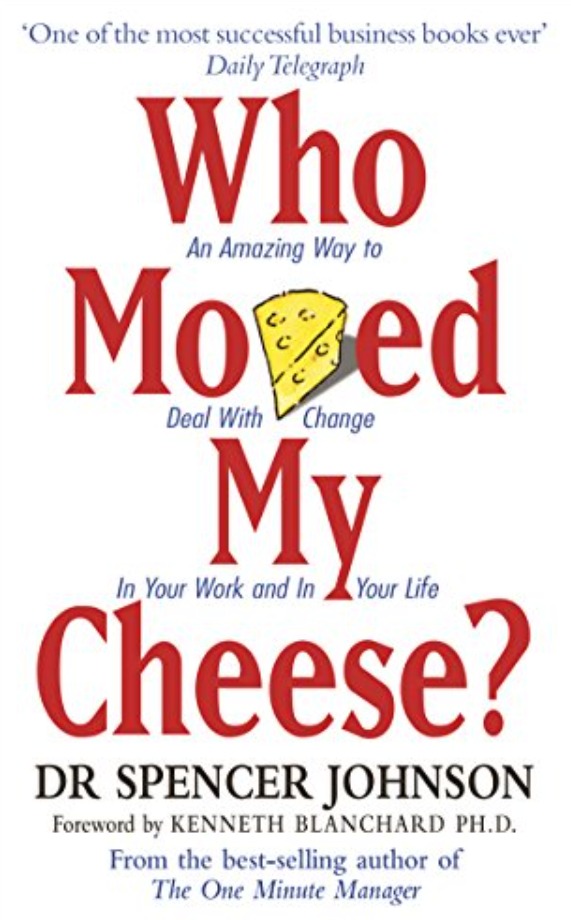Who Moved My Cheese? by Spencer Johnson is a popular business and self-help book that uses a simple parable to illustrate how people react to change in their lives, particularly in their careers and relationships. The book’s insights focus on the importance of adaptability, proactivity, and a positive outlook in the face of uncertainty and shifting circumstances.

Summary of Key Elements in the Book
The story is set in a maze where four characters search for cheese, which symbolizes happiness, success, or whatever each person desires in life. The four characters represent different attitudes and approaches toward change:
Sniff and Scurry: These two characters are mice who use their instincts to seek out cheese. They are quick to adapt and constantly stay alert for changes in their environment.
Hem and Haw: These two are “Littlepeople” with human traits and personalities. Hem resists change and clings to his routines, while Haw is initially hesitant but gradually learns to embrace change.
The Plot: Searching for Cheese
The characters discover a large stash of cheese in a particular part of the maze, which they call “Cheese Station C.” Each day, they go to this location to enjoy the cheese they’ve found. Over time, however, the mice and Littlepeople develop different attitudes toward their cheese supply.
Sniff and Scurry remain vigilant and occasionally check if the cheese supply is dwindling.
Hem and Haw, on the other hand, grow complacent. They assume the cheese will always be there, and they become attached to it.
One day, the cheese at Cheese Station C disappears. This is where each character’s approach to change becomes apparent.
Responses to Change
Sniff and Scurry: The two mice quickly accept that the cheese is gone. Without overthinking, they adapt, move on, and begin to search the maze for new cheese. Their quick response symbolizes the power of adaptability and readiness to embrace change.
Hem and Haw: The Littlepeople react differently. Hem resists change and refuses to leave Cheese Station C, convinced that the cheese will return if he waits long enough. He grows angry and fearful, blaming external forces for his predicament. Haw, though initially reluctant, starts to question their approach. Gradually, he realizes that their situation won’t improve unless they do something differently.
Haw’s Journey: Learning to Embrace Change
Haw ultimately decides to venture out of his comfort zone and search for new cheese. As he moves through the maze, he learns several important lessons about change:
Anticipate and Prepare for Change: Haw understands that change is inevitable and that being prepared can help prevent the shock of sudden loss.
Let Go of the Past: He realizes that clinging to what worked before keeps him from finding new opportunities. Moving forward requires letting go of the “old cheese” that is no longer there.
Visualize Success: Haw imagines himself enjoying new cheese, which motivates him to keep searching. Visualizing success helps him stay focused and positive even when he faces setbacks.
Enjoy the Adventure: As he searches, he learns to embrace the process rather than fixate on the destination. This shift helps him find joy in the journey, not just the end result.
Haw leaves messages on the walls of the maze as he goes, intending to encourage Hem or anyone else who might come after him. Eventually, he discovers a new cheese station, even better than the first, filled with an abundant variety of cheese. Haw realizes the rewards of embracing change and decides to stay adaptable in case the cheese supply shifts again.
Key Lessons in the Book
The parable concludes with a discussion among a group of friends who reflect on the story and how it relates to their lives. The main takeaways include:
- Change is Inevitable: Change happens in all areas of life, whether we’re prepared for it or not. Adapting to change is essential for success and personal growth.
2. Don’t Dwell on Loss: When things don’t go as expected, dwelling on what’s lost only prevents progress. Moving on and looking forward is necessary to find new opportunities.
3. Take Action Quickly: Sniff and Scurry demonstrate that acting quickly in response to change is often the best approach. The longer one hesitates, the harder it becomes to adjust.
4. Stay Vigilant and Adaptable: By regularly assessing one’s circumstances and staying open to new paths, it becomes easier to adjust when change occurs.
5. Visualize Success to Stay Motivated: Haw’s journey underscores that imagining a positive outcome helps maintain motivation and optimism.
6. Embrace the Journey: Life’s changes can be unsettling, but they also present opportunities for growth, learning, and discovery.
Conclusion: Adapting to Change for Personal Growth
Who Moved My Cheese? closes with a reflection on how people can use these lessons in their own lives. Johnson’s parable encourages readers to adopt a positive and flexible attitude toward change, emphasizing that those who can let go of old comforts and remain proactive are the ones who thrive.
In summary, the book conveys that change is a constant part of life, and the ability to adapt to change with resilience, optimism, and a willingness to explore new paths can lead to personal growth and happiness.
